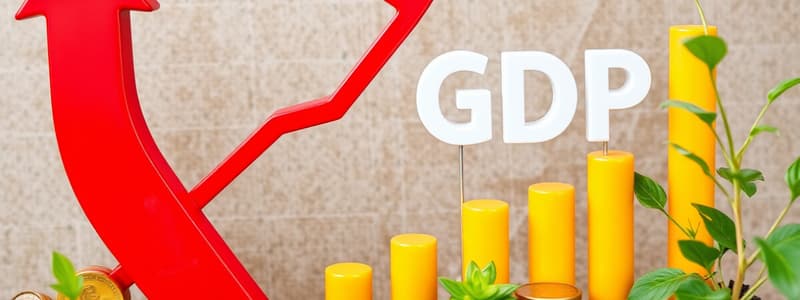Podcast
Questions and Answers
What does economic growth refer to?
What does economic growth refer to?
- Increase in real GDP per capita over a time period (correct)
- Economic decline
- Decrease in real GDP
- Increase in real GDP occurring in a time period (correct)
What is Real GDP Per Capita?
What is Real GDP Per Capita?
Measures economic growth; found by dividing real GDP by size of population.
Why is economic growth important?
Why is economic growth important?
It allows people to meet their economic wants and lessens the burden of economic scarcity.
What are the four phases of a business cycle?
What are the four phases of a business cycle?
What is Potential Output?
What is Potential Output?
What is the GDP gap?
What is the GDP gap?
What does Okun's Law state?
What does Okun's Law state?
What is Inflation?
What is Inflation?
What does CPI stand for?
What does CPI stand for?
What is Demand Pull Inflation?
What is Demand Pull Inflation?
What is Cost Push Inflation?
What is Cost Push Inflation?
What are Per Unit Production Costs?
What are Per Unit Production Costs?
What is Nominal Income?
What is Nominal Income?
What is Real Income?
What is Real Income?
What is Anticipated Inflation?
What is Anticipated Inflation?
What is Unanticipated Inflation?
What is Unanticipated Inflation?
What are Cost of Living Adjustments?
What are Cost of Living Adjustments?
What is the Real Interest Rate?
What is the Real Interest Rate?
What is the Nominal Interest Rate?
What is the Nominal Interest Rate?
What is Deflation?
What is Deflation?
What is Hyperinflation?
What is Hyperinflation?
What does the Rule of 70 tell us?
What does the Rule of 70 tell us?
What is Productivity?
What is Productivity?
What is a Business Cycle?
What is a Business Cycle?
What is Peak in a business cycle?
What is Peak in a business cycle?
Flashcards are hidden until you start studying
Study Notes
Economic Growth
- Economic growth refers to an increase in real GDP or real GDP per capita over a specified time period.
- Real GDP per capita is calculated by dividing real GDP by the total population, providing a measure of economic performance relative to population size.
Importance of Economic Growth
- Economic growth enables individuals to fulfill their economic desires and mitigates the effects of scarcity.
- A slight difference in growth rates, such as between 2.5% and 3%, can profoundly impact standards of living over decades, potentially affecting basic survival needs.
Business Cycle
- The four phases of a business cycle are peak, recession, trough, and expansion.
- Business cycles vary in length, with fluctuations influenced by seasonal variations and long-term trends, complicating their measurement.
- Capital goods and consumer durable goods industries experience more severe effects during cycles than consumer nondurables due to the discretionary nature of their purchases.
Potential Output and GDP Gap
- Potential output represents the real economic output when all available resources are utilized efficiently.
- The GDP gap is the difference between actual gross domestic product and potential output, which can be positive or negative.
Okun's Law
- A rise of one percentage point in the unemployment rate above the full employment level typically increases the GDP gap by two percent of potential output.
Inflation and Price Indexes
- Inflation denotes an increase in the general price level across the economy.
- The Consumer Price Index (CPI) measures the cost of a fixed basket of about 300 goods and services used by the average consumer.
Types of Inflation
- Demand-pull inflation occurs when aggregate demand exceeds production capacity, leading to higher prices.
- Cost-push inflation arises from rising resource costs, resulting in increased price levels.
Income Measures
- Nominal income is the actual dollar amount received over a period without indexation for inflation.
- Real income reflects purchasing power, adjusted to account for inflation, indicating how many goods and services can be bought with nominal income.
Inflation Expectations
- Anticipated inflation is the price rise expected to occur, while unanticipated inflation occurs at rates higher than those expected.
- Cost of living adjustments are automatic income increases for workers to maintain purchasing power during inflation, ensured by collective bargaining.
Interest Rates
- Real interest rate represents the nominal interest rate minus the expected inflation rate, reflecting true purchasing power.
- Nominal interest rate indicates the current annual interest charged, not adjusted for inflation.
Deflation and Hyperinflation
- Deflation refers to a general decline in the price level within an economy.
- Hyperinflation describes a rapid and extreme increase in the price level, leading to severe economic instability.
Growth Measurement
- The Rule of 70 calculates the time it takes to double real GDP by dividing 70 by the annual growth rate percentage.
- Productivity is assessed as real output generated per unit of input, indicating efficiency in production.
Business Cycle Overview
- The business cycle comprises periodic expansions and contractions in economic activity, with its four stages being recession, trough, expansion, and peak.
Studying That Suits You
Use AI to generate personalized quizzes and flashcards to suit your learning preferences.




